nForce 590 SLI Intel Edition: NVIDIA prepares an Intel 975X Killer
by Gary Key on June 27, 2006 6:15 AM EST- Posted in
- CPUs
NVIDIA nForce 590 SLI: Reference Board Layout
NVIDIA designed a very well laid out board with all major connections easily reached. The board is lacking most clearance issues and was very easy to install in our mid-size ATX case. The reference board features an excellent voltage regulator power design along with Rubycon and Sanyo capacitors that yielded superb stability and overclocking results even with our early BIOS and board design.
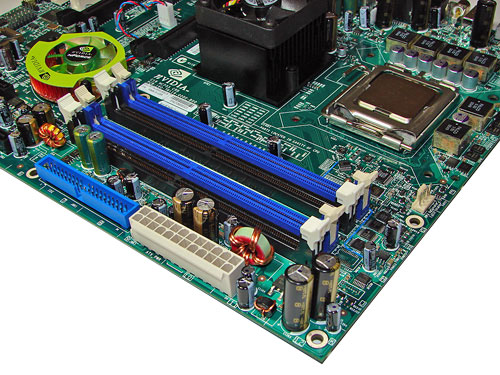
The DIMM module slots' color coordination is correct for dual channel setup based upon the premise of utilizing different colors for each memory bank. The memory modules are easy to install with a full size video card placed in the first PCI Express X16 slot. The 24-pin ATX power connector is located along the upper edge of the board along with the single IDE port connector.
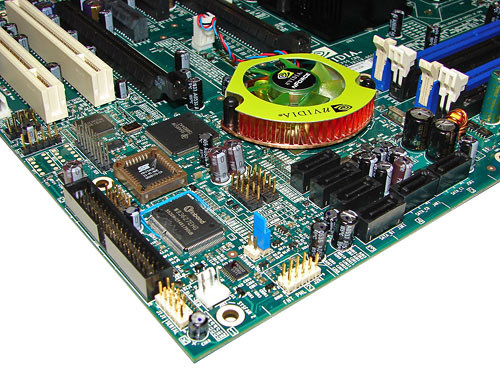
The six NVIDIA SATA ports are color coded black and are conveniently located below the NVIDIA MCP. The SATA ports feature the newer clamp and latch design. We found the positioning of the SATA ports to be excellent when utilizing either PCI-E X16 slot. The NVIDIA MCP does require a heatsink in this application.
The floppy drive connector is color coded black while being positioned along the left edge of the board. The location of this connector is not ideal and actually the whole point of having a floppy drive connector is becoming moot with the wide spread availability of USB floppy or flash drives along with BIOS support for boot purposes. The various chassis panel, USB connectors, and the second chassis fan header are located in the lower left portion of the board.
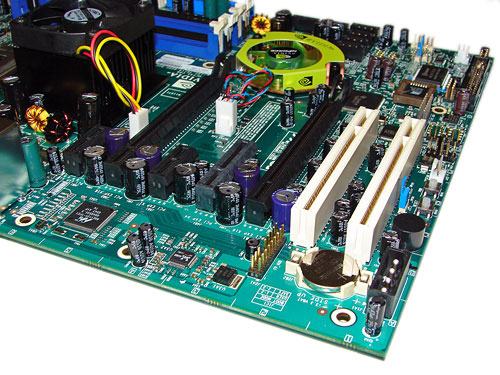
The board comes with (2) physical PCI Express X16 connectors, (1) PCI Express X1 connector, (1) PCI Express X4 connector, and (2) PCI 2.3 connectors. The layout of this design offers a very good balance of expansion slots for a mainstream board while providing excellent clearance space for graphics card utilization. Our main issue is that the first PCI 2.3 connector will be rendered physically useless if an SLI setup is utilized. Although the positioning and number of PCI-E and PCI slots are up to the manufacturer, we certainly hope to see better layouts that do not block the PCI slots in the near future. A four-pin molex power connector that is required for SLI operation and the first chassis fan header is located along the edge of the board. The four-pin molex connector is located in an unusual and difficult location to reach, the bottom left corner.
Returning to the CPU socket area, we find an ample amount of room for alternative cooling solutions. We utilized the stock heatsink/fan in our normal testing but also verified a couple of larger Socket 775 cooling solutions would fit in this area during our overclocking tests.
The NVIDIA SPP is actively cooled with a medium sized heatsink/fan unit that did not interfere with any installed peripherals. In fact this unit kept the chipset cool enough that additional chipset voltage was not a factor in our overclocking tests, although we could see this unit heating up if the HSF is not seated properly. Our only concern is the lifespan of the fan but it is very quiet during operation. NVIDIA places the 8-pin 12V auxiliary power connector at the top of the CPU socket area but out of the way of aftermarket cooling solutions.
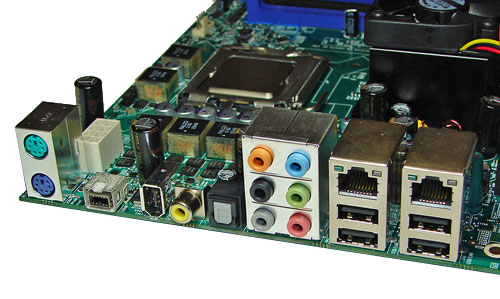
The rear panel contains the standard PS/2 mouse and keyboard ports, LAN ports, and 4 USB ports. The LAN (RJ-45) ports have two LED indicators representing activity and speed of the connection. The audio panel consists of 6 ports that can be configured for 2, 4, 6, and 8-channel audio connections. The rear panel also includes two S/PDIF (optical/coaxial) ports, an external SATA 3Gb/s port, and an IEEE 1394a port.
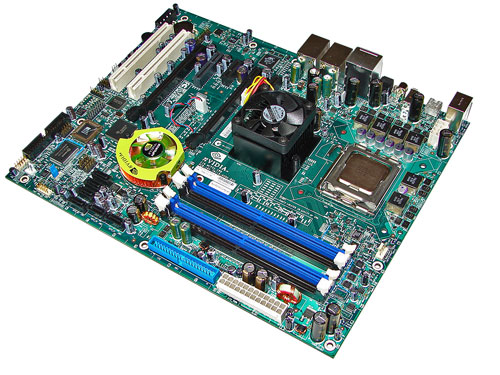 |
| Click to enlarge |
NVIDIA designed a very well laid out board with all major connections easily reached. The board is lacking most clearance issues and was very easy to install in our mid-size ATX case. The reference board features an excellent voltage regulator power design along with Rubycon and Sanyo capacitors that yielded superb stability and overclocking results even with our early BIOS and board design.

The DIMM module slots' color coordination is correct for dual channel setup based upon the premise of utilizing different colors for each memory bank. The memory modules are easy to install with a full size video card placed in the first PCI Express X16 slot. The 24-pin ATX power connector is located along the upper edge of the board along with the single IDE port connector.

The six NVIDIA SATA ports are color coded black and are conveniently located below the NVIDIA MCP. The SATA ports feature the newer clamp and latch design. We found the positioning of the SATA ports to be excellent when utilizing either PCI-E X16 slot. The NVIDIA MCP does require a heatsink in this application.
The floppy drive connector is color coded black while being positioned along the left edge of the board. The location of this connector is not ideal and actually the whole point of having a floppy drive connector is becoming moot with the wide spread availability of USB floppy or flash drives along with BIOS support for boot purposes. The various chassis panel, USB connectors, and the second chassis fan header are located in the lower left portion of the board.

The board comes with (2) physical PCI Express X16 connectors, (1) PCI Express X1 connector, (1) PCI Express X4 connector, and (2) PCI 2.3 connectors. The layout of this design offers a very good balance of expansion slots for a mainstream board while providing excellent clearance space for graphics card utilization. Our main issue is that the first PCI 2.3 connector will be rendered physically useless if an SLI setup is utilized. Although the positioning and number of PCI-E and PCI slots are up to the manufacturer, we certainly hope to see better layouts that do not block the PCI slots in the near future. A four-pin molex power connector that is required for SLI operation and the first chassis fan header is located along the edge of the board. The four-pin molex connector is located in an unusual and difficult location to reach, the bottom left corner.
 |
| Click to enlarge |
Returning to the CPU socket area, we find an ample amount of room for alternative cooling solutions. We utilized the stock heatsink/fan in our normal testing but also verified a couple of larger Socket 775 cooling solutions would fit in this area during our overclocking tests.
The NVIDIA SPP is actively cooled with a medium sized heatsink/fan unit that did not interfere with any installed peripherals. In fact this unit kept the chipset cool enough that additional chipset voltage was not a factor in our overclocking tests, although we could see this unit heating up if the HSF is not seated properly. Our only concern is the lifespan of the fan but it is very quiet during operation. NVIDIA places the 8-pin 12V auxiliary power connector at the top of the CPU socket area but out of the way of aftermarket cooling solutions.

The rear panel contains the standard PS/2 mouse and keyboard ports, LAN ports, and 4 USB ports. The LAN (RJ-45) ports have two LED indicators representing activity and speed of the connection. The audio panel consists of 6 ports that can be configured for 2, 4, 6, and 8-channel audio connections. The rear panel also includes two S/PDIF (optical/coaxial) ports, an external SATA 3Gb/s port, and an IEEE 1394a port.










37 Comments
View All Comments
rallyhard - Friday, June 30, 2006 - link
I, too, would like to see some RAID benchmarks for the motherboards when they're reviewed. Maybe even just reviewing the performance of a particular HD/RAID controller once, when it is tested on the first motherboard that you come across with that controller, would suffice.(I don't know how much HD/RAID performance varies from mobo to mobo with the same controller)
I certainly wouldn't have bought my Gigabyte 7n400 Pro2 socket A board if I had known the performance penalty of running RAID on the ITE 8212 chip as opposed to running a single drive on the nForce2 controller. The IDE raid functionality was the only reason I chose that board over the Abit NF7. The only way I found out that my horrible performance was truly and solely due to that 8212 chip is by doing a search on that chip and reading forums.
Incredibly, some manufacturers are still using that same chip for their IDE.
Anyway, I'm sure IDE performace is now a moot point for most, but yeah, RAID performance testing on future mobo (or controller) testing would, to me, be a useful addition to your excellent reviews.
Keep up the good work!
Crassus - Tuesday, June 27, 2006 - link
Perhaps someone can enlighten me on this: How much of an real-world impact in contemporary games does SLI 8/8 lanes compared to 16/16 lanes have? I remember reading an article about this issue back in the days when PCI-E was introduced, but I haven't really heared anything about it since. So, did anyone do a test on this?DigitalFreak - Tuesday, June 27, 2006 - link
I think X-Bit did a test not so long ago, and concluded there is still no advantage of 16x16 over 8x8.Avalon - Tuesday, June 27, 2006 - link
Sheesh, this is a pre-production board.CrystalBay - Tuesday, June 27, 2006 - link
Sheesh, look at the size NB fan.nullpointerus - Tuesday, June 27, 2006 - link
Just below the big features table on the basic features page, there's a sentence which should read:"Intel didn't officially want their 975X chipset to support 533FSB processors, but [a few] motherboard manufacturers disagreed on this point[, and] the end result is that 975X motherboards are able to run Celeron D chips."
At least I think that's how it's supposed to read.
nullpointerus - Tuesday, June 27, 2006 - link
Further down:"Considering the layout of expansion slots on ATX/BTX motherboards, [this] would be our ideal configuration, and the remaining expansion slots can be filled out with either X1/X2 PCI-E or regular PCI connectors."
...and also:
"There really doesn't see[m to be] much point in including X1 physical slots, particularly on enthusiast level hardware, and ATI at least has already recommended that motherboard manufacturers begin including more X16 physical connectors."
Gary Key - Tuesday, June 27, 2006 - link
Jarred and I got our wires crossed during the edit process this morning, it was easy to do at 5:30am after being up for about 26 hours with this board and another "new" chipset preview that should be finished shortly. ;-> However, no excuse on my part for not noticing the missing/incorrect text. I have corrected our mistakes and sincerely hope the changes are acceptable. Thank you for the comments and taking time to write. :)PedroDaGr8 - Tuesday, June 27, 2006 - link
I noticed on the compression/decompression page, page 7 I think. Both of the graphs are labeled File compresision - WinRAR 3.60b5 602MB Test Folder - Time In Minutes - Lower Is Better. Shouldn't one of them (the bottom one I guess) be labeled File Decompression, or atleast since you mention it first in the article shouldn't it be on top. That led to a quick bout of confusion for me, hey maybe it is just the painpills (I blew out my knee last week, tore my ACL and LCL (Lateral Colateral Ligament) with possible damage to my PCL and MCL as well. Nothing like playing cricket for the first time and injuring yourself.JarredWalton - Tuesday, June 27, 2006 - link
I added a word to the subtitle now. Basically, File Compression is the benchmark category, followed by the benchmark application. The subtitle is for extra information about the particular test. Hopefully that makes sense - I can't say my brain is entirely functional at this hour of the morning. :)